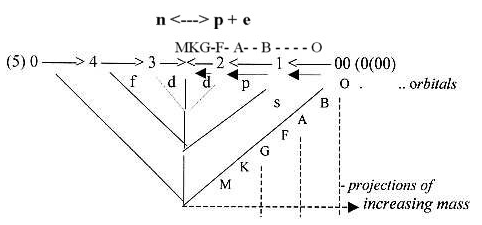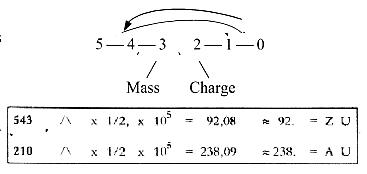| Astronomy / - a 5-dimensional model tested on the planet system and other data - |
|
Astronomy
- links:
|
Elements - links:
|
The Genetic Code -
links:
|
Language - links
|
|
Stars.
galaxies...
2. Stars |
Neutrons n representing uncharged mass, protons and electrons the polarization in charges. (Cf. too the p/e-quotient.)
Temperatures from ~ 40.000° to 2.400°. (Range
widened through later observations of new stars.) Magnitudes are by scientists divided in 5 steps, the 5th root of 100 = 2,512 as factor. It give the number chain:
It can be observed that middle 4 numbers also approximates
surface temperature steps for stars on the main sequence
above divided in 3 steps with quotient 5/2 = 2,5 (the middle
also in d-degrees in the dimension chain.):
also reflecting the complementary and polarity principle of the loop model?. (More about spectral classes below.)
A common description defines 5 main phases:
Hence, astronomers count on 2 main different phases of fusion, of H to He and of He to heavier elements, and 3 main phases of contraction from birth to death. A first addition: Also in the very first step there is
a polarization observed between denser, cooler areas in
the clouds and hotter thinner areas. (Curiously contradicting
thermodynamic laws as it seems.) Gravitational energy in
the denser area is then self-strengening and transformed
to heat according to common descriptions. (What happens
with the hotter, peripheral area of clouds?) Fusion need both a certain degree of density and of high
temperature. In any case life time phases of stars may be described in 3 main steps along the Time axes:
3 alternatives for collapses too, mass-depending: a) black holes, b) neutron stars, c) white dwarfs. An attempt to illustrate the 3 stages in a dimension
chain:
The figures below are built on following aspects: - The relation core - shell as a relation c-ac, 0 and 00-poles, also higher d-degrees in relation to lower ones. - The two different parts of contractions: a) for fusion,
b) for collapses, related to the border in middle step 3-2:
mass polarized into charges, n —> p + e + ν.
Mass - Charge properties a relation d-degree 3 to 2 in the
dimension model. - Associations with d-degrees in the figures built on the
2x2-chain, x = 5 - 0,where intervals mark electron
orbitals s - p - d..., in connection with synthesized elements
in these orbitals: See
figure 8, figure
9, figure
11 below. - The ambiguous relation between density and temperature: demanded increasing temperature in the core for fusion of heavier elements, connected with decreasing surface temperature. Density and Temperature properties primarily dined in opposite ends of the dimension chain. To the life time stages above it has to be added that very massive stars also can undergo series of smaller development phases during fusion of heavier elements. a) Life time, fusion: - Centres here in the middle step: cores with decreasing
size vertically upwards. - Released energy: steps from radiation toward more closed
"circles" as convection in denser cores. One question concerns the polarizations in the 3 processes,
diagonal arrows, in physical interpretation. To take the
apparently best known of these, when stars at the end of
the phase on main sequence transform to red giants: Why
do their cores "suddenly" contract, why do their
shells blow up ? Presumably the same view is or may be described in other
more scientifically established terms by astronomers. However,
only "radiation pressure" or similar expressions
shouldn't be enough to explain these "jumps" in
the processes. (?) b) End of fusion: Collapses of charge in step 3-2 on the left side of the middle
Left side of the border n <—|—> p + e
+ ν (anti-ν:
- Degeneration pressure is proportional to the density,
obviously in two different steps 5/3 → 4/3: The polarizations horizontally: as through the FA -force. What should here diagonals represent and vertical
steps, the "relations"? - Hence, first suggestion is that they represent attraction forces around black holes and neutron stars, also then around white dwarfs (?). Cf. for instance that the rotational energy of neutron stars as pulsars is transmitted to their whole nebula, indicating such attraction bonds. - Secondly they may mark the circular structures between centre and anticentre in d-degree step 3-2 of galaxies and solar systems. (From the perpendicular relation FG /FA .) - Pointing to the unpolarized 5 - 5' - 5" levels,
they could eventually also be defining new centres for aggregations
of matter ? (And "corridors" of thrown out matter
for new phases of contraction and fusion "the other
way around", for solar systems, planets - star clusters
- galaxies (galaxy clusters ?), - Finally the diagonals in both life time and end figures
could illustrate the combination of high density and high
temperature created in the cores of stars, the combination
of the opposite properties. It obviously have to imply a
transformation of gravity to temperature "through work",
in opposition to temperature as high kinetic energy. Or
more adequate to high temperature as high spread
of velocities? One example would be "M-sigma"-relations
between high "mass" of black holes and spread
of star velocities around them (stars corresponding
to particles, see file Temperature)?
Generally in the figure there are more of structure and mass as structure in higher degrees, left side of the dimension chain, more of motions and kinetic energy in lower degrees, right half of the figure (thrown out matter), according to the model. A in our own solar system the sun represents most of the mass (~ left side of figure above), planets most of the impulse moment, i.g. most of kinetic energy. An older figure:
Synthesis of elements in the periodic system - first 2 - 3 steps:A series 2x2 , (x= 5-0) defines the number for electrons in orbitals s-p-d-f and additions for whole shells in the periodic system. - 1st synthesis in stars H → He concerns elements
in orbital s1, The orbital elements as corresponding to illustration of
phases above: Steps of synthesis as multiplications: 1 u x 4 →x
3 →x 2 → x 2:
(Cf. "A-Z"-number chain below.) A general statement connects synthesis of the heavier elements here to the sub-phases of smaller contractions in cores of "variables", circa 1/3 of red giants. A suggestion is that the 3rd and 4th steps of fusion above
could include features corresponding to spx-
and spdx-hybridizations on the molecular level.
The series implies a spectral development roughly from
The star series from O to M on the main sequence corresponds
to decreasing masses according to the Hertzsprung-Russel
diagram (HR). From hotter massive stars to cooler in
the middle. K-stars on the main sequence are orange dwarfs,
M-stars red dwarfs. Notes: It seems to be a contradiction between the astronomers'
statements that stars on the main series only synthesize
H → He, and that all the spectral classes but the
very first part of O-B-stars include spectral lines from
increasingly heavier elements. The most accepted answer
seems to be that all the following spectral classes are
later generations of stars from clouds already containing
matter thrown out from earlier red giants. Our sun is a G-star surrounded by inner planets containing
heavy elements, in fact nearly all, even Uranium. It's assumed
that the sun is a later generation of an earlier one, explaining
these heavy inner planets, but why then in exactly the same
place ? Couldn't the inner planets and the outer ones of
light elements reflect inversely thrown out material from
deeper levels of the same sun in older times? It's in any case an accepted proposition that not only H→He synthesis but also the CNO-cycle does occur in our sun.
It could be observed that they also are 3 in number. "A-Z-number chain", illustrating
processes 1 and 2:
First two processes may be illustrated by the "A-Z"
number chain, 2 ways to synthesize He, both in our sun on
the main sequence. (From Chemical
elements):
Right half: scientists imagine a process: The figure illustrates a clear division of the two processes
as between first and second half part of the chain. Hence, 2 cyclic processes is given for synthesis and disintegration
for He-production; steps 4-3 and 2-1 corresponding to each
other in the loop model. Polarizations outwards, as "decay",
aggregations inwards, expressions for the complementary,
opposite forces.
The fact that middle number for B is mostly found in interstellar
space (and Be, 8-4, Li 6-3 as well, "numbers depending"
directly and indirectly on B) may support the loop model.
Lower steps possible to regard as debranched from higher
degrees "meeting the other way around". (What
about O (16-8) and N (14-7) in interstellar space - for
symmetry? - A special mystery, which the "A-Z"-figure
eventually could shed some light upon, is the appearance
of double OH-lines in spectrum from cool M-stars and in
H+-clouds. (They should curiously correspond to two different
velocities of the objects.) (A correspondence to photolysis in macrocosm?) Cf. the polarization already in big Hx-clouds
between hot, thinner and cool, denser areas! 3rd process, triple-alpha: In "A-Z"-number terms we get this 3rd process
called "triple-alpha" in the middle
of the chain, in step 3 - 2.
The term "resonance" sounds as it could support
the loop model with original polarizing steps towards middle
of the chain and "border" in this step. "Energies"
perhaps only equal in this step 5 → 3-2 ? Resonance
as balance between acting polarizing-synthesizing forces
(FG / FA)
on underlying level).
Elements heavier than Fe/Ni:
The scientists' explanation today is that the heavier
elements originate from "neutron capture" of lighter
elements (slow or rapid as indicating a border between two
types).
With the properties Mass and Charge related as d-degrees
3 to 2, it may be seen as expressed in the reactions n <—>
p + e (+ ν, anti-ν.
An additional view, suggested here, would be to interpret the neutron capture as an expression for the involvment of left part in the chain above: imagine the masses of heavier elements as defined, more or less indirectly (through "resonances"?), in left part of the chain through the steps in the right part where we have the "endogen" fusion of lighter elements. In accordance with the loop model. Cf. perhaps inversions: all elements down to "about 150" u are said to undergo fission processes, the inversion 150 /\ 67. (10x), 67 a bit higher than highest stable isotope of Ni 60, end of right side fusion processes. 60 /\ 167 u (x 10x).
With reference to views in the paragraph above and to the
mentioned mysterious double spectral bands of OH, it seems
possible to interpret the curious Ap-stars in a similar
way, expressions for the loop connections between higher
and lower steps in the dimension chain?
The supposed view however doesn't appear so simple as in
the figure:
Uranium - Hydrogen: The two halves of the dimension chain as triplets:
Here it should also be observed that taking the quotient between the two superposed numbers as representing opposite direction in the chain we get: 975 / 531 (x102) ≈ 2 x 92, Z-number of Uranium, 531 / 975 (x102)≈ 2 x 27, Z-number middle of Fe 26 Z and Ni 28 Z. (Number 54 not only the surplus of neutrons
in Uranium but also the "endogen" fusion.)
*
|
© Åsa Wohlin
Free to distribute if the source is mentioned.
Texts are mostly extractions from a booklet series, made publicly available in year 2000
LINKS HEREMACROCOSM1.
Levels PLANET SYSTEM Tables: Planets, Distances in AE 1. Planet distances in AE - Exponent 3/2 2.
Planet distances 3.
Planet distances out of a 4. A graph for planet distances in AE Masses in Earth units 0.
Planet masses 1.
Masses of planets 2.
Masses of planets from 3.
Masses of planets from * Latest updated
|



















